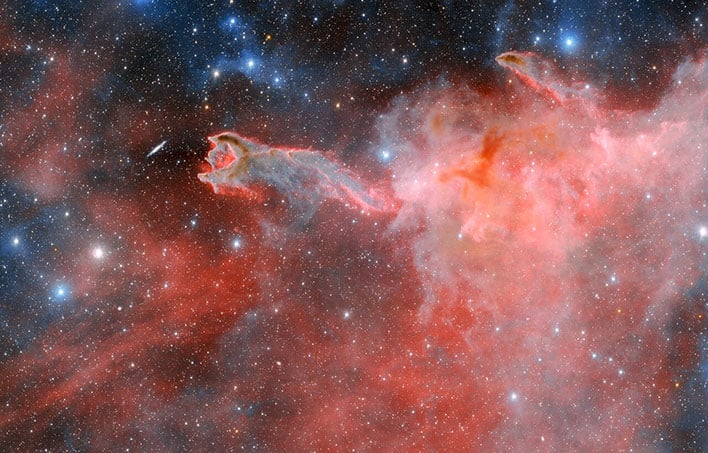Dark Energy Camera Snaps Stunning Photo Of God’s Hand Reaching Across The Cosmos
An image captured by the Department of Energy-built Dark Energy Camera (DECam) showcases cometary globule CG 4, better known as “God’s Hand,” reaching through the cosmos in magnificent detail. CG 4 lies about 1,300 light-years away, in the constellation Puppis, and is only one of many cometary globules within the vast Milky Way.
Cometary globules were first detected in 1974 from images taken with the UK Schmidt Telescope in Australia. The reason they were able to stay hidden away from astronomers for so long is the fact that they appear so faint. The celestial object’s tails are shrouded in dark stellar dust, which block most light from passing through. According to NOIRLab, with the aid of the Hydrogen-alpha filter, the DECam can detect the faint red glow of ionized hydrogen present within CG 4’s head and around its outer rim.
“God’s Hand” and other cometary globules are a subclass of the dark nebulae known as Bok globules. These are isolated clouds of thick cosmic gas and dust which are surrounded by hot, ionized material. It is when these clouds show an extended tail that they are referred to as cometary globules because of the slight resemblance to a comet.
CG 4’s head has a diameter of 1.5 light-years, with the tail stretching out about 8 light-years. Even those these dimensions may sound incredibly expansive, they are comparatively small in terms of other Bok globules. NOIRLab notes that the light by CG 4 produces occurs when hydrogen becomes excited after being assailed by radiation from nearby hot, massive stars. Ironically, however, the intense radiation produced by the neighboring massive stars is also gradually destroying the head of CG 4, and clearing away the tiny particles that scatter the starlight.
Also shown in the recent image of “God’s Hand” is the edge-on spiral galaxy ESO 257-19, which appears in front of CG 4. While the spiral galaxy may look nearby to the cometary globule, it actually exists more than a hundred million light-years away.
Cometary globules were first detected in 1974 from images taken with the UK Schmidt Telescope in Australia. The reason they were able to stay hidden away from astronomers for so long is the fact that they appear so faint. The celestial object’s tails are shrouded in dark stellar dust, which block most light from passing through. According to NOIRLab, with the aid of the Hydrogen-alpha filter, the DECam can detect the faint red glow of ionized hydrogen present within CG 4’s head and around its outer rim.
“God’s Hand” and other cometary globules are a subclass of the dark nebulae known as Bok globules. These are isolated clouds of thick cosmic gas and dust which are surrounded by hot, ionized material. It is when these clouds show an extended tail that they are referred to as cometary globules because of the slight resemblance to a comet.
CG 4’s head has a diameter of 1.5 light-years, with the tail stretching out about 8 light-years. Even those these dimensions may sound incredibly expansive, they are comparatively small in terms of other Bok globules. NOIRLab notes that the light by CG 4 produces occurs when hydrogen becomes excited after being assailed by radiation from nearby hot, massive stars. Ironically, however, the intense radiation produced by the neighboring massive stars is also gradually destroying the head of CG 4, and clearing away the tiny particles that scatter the starlight.
Also shown in the recent image of “God’s Hand” is the edge-on spiral galaxy ESO 257-19, which appears in front of CG 4. While the spiral galaxy may look nearby to the cometary globule, it actually exists more than a hundred million light-years away.


